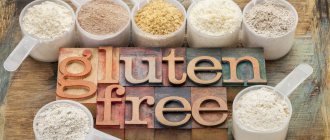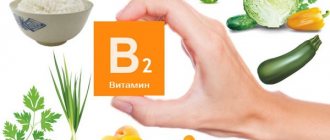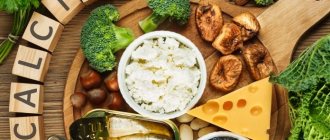One of the most important trace elements in the human body is iron; it is responsible for the proper functioning of a number of vital systems. Too little or too much of this metal immediately affects a person’s well-being. Although both conditions negatively affect people's health, most often people have a lack of iron in the body.
For all girls, their appearance is of great importance - ideal skin without rashes, a slim figure, but few people know that following a diet and regular exercise with a lack of iron will not give the desired result. Proper functioning of the thyroid gland and rapid metabolism depend on a sufficient amount of iron.
Let's consider the role of iron in the body, consumption rates, causes and symptoms of iron deficiency in the body, as well as foods containing iron in large quantities.
What affects the body's need for iron?
It is difficult to give a complete and accurate answer to this question without knowing the key parameters, namely:
- age;
- floor;
- state of the body (regular donation, large blood loss, postoperative period, pregnancy, lactation).
Unfortunately, many people, before a health crisis arises, do not think about what the norm of iron consumption is, what foods contain the mineral. Preventive measures are much simpler and easier to follow than actively treating concomitant diseases, as well as systematic diseases that begin to manifest themselves with Fe deficiency.
First, you need to understand how much the daily intake of iron is for different categories of people.
How much iron is required per day for men
On average, the daily iron requirement for men is up to 10 mg. But this indicator is quite conditional, since if there are problems with blood supply, with a low hemoglobin level, or anemia of various stages, the need for the daily requirement of iron for men may increase. Among the basic factors that increase the daily iron intake for a healthy man over the age of 30, it is worth highlighting the following:
- active physical activity;
- extended working hours;
- taking certain medications, such as sexual stimulants.
What determines the daily iron requirement for women?
Representatives of the fair half of humanity need a larger amount of the mineral than men. Therefore, it is important to know the daily iron requirement for women in mg.
The fact is that women have a more active metabolism, regular menstruation, and it is necessary to replenish the body with useful microelements for an established blood metabolism process. For a girl, starting from puberty, the daily intake of iron is 18 mg. After menstruation or surgery, the dose is increased to 20 mg.
Girls who often “go on a diet”, along with the extra pounds and centimeters in volume, literally “wash” the mineral out of the blood. Therefore, if you are planning long fasting days, you should leave foods rich in Fe in your diet and first consult with a nutritionist, a specialist in healthy nutrition.
Why does the body's need for iron increase during pregnancy?
For those ladies who are planning to become a mother, the daily iron intake can be increased to 25 mg. During pregnancy, in particular in the first trimester, when the fetus is developing organs, especially an independent circulatory system, as well as during lactation, the rate of iron consumption per day increases almost 2 times.
It is especially important to ensure adequate iron intake during pregnancy. A low level provokes the development of anemia, which is critical for the expectant mother and child. The daily iron requirement for anemia in pregnant women usually increases. Lack of oxygen in tissues can cause irreversible consequences: improper development of the nervous and circulatory system in the baby, oxygen starvation, edema, shortness of breath in the mother. To prevent this from happening, the woman is prescribed special medications containing iron.
Even in the absence of diagnosed anemia during pregnancy, gynecologists recommend revising the daily iron intake for women by adding foods that contain it in the proper quantities to the diet: boiled beef and liver, apples, walnuts. Vitamin complexes with this mineral are often additionally prescribed.
It is extremely important for pregnant women to remember that iron is absorbed more quickly and fully by the body along with vitamin C, which is abundant in seasonal fruits and vegetables, as well as in fortified complexes in the form of tablets and syrups.
After the baby is born, the daily iron intake continues to be 40–50 mg, since blood loss during childbirth can cause rapidly developing anemia. This is why it is so important to follow the daily iron requirement for women with anemia.
Table of foods containing iron
The table shows products of plant and animal origin containing iron (data are given in mg per 100 g).
As you can see, the most trace elements are found in pork and chicken liver, as well as in shellfish. Products of plant origin, such as soybeans, lentils, and wheat bran, are not much inferior in numbers. But remember that the absorption of the latter by the body is 2 times lower. Animal products
| The product's name | Iron content in mg per 100 g |
| pork liver | 20,2 |
| chicken liver | 17,5 |
| beef liver | 6,9 |
| beef heart | 4,8 |
| pork heart | 4,1 |
| beef meat | 3,6 |
| lamb meat | 3,1 |
| pork meat | 1,8 |
| chicken's meat | 1,6 |
| turkey meat | 1,4 |
| oysters | 9,2 |
| mussels | 6,7 |
| sardines | 2,9 |
| black caviar | 2,4 |
| chicken yolk | 6,7 |
| quail yolk | 3,2 |
| beef tongue | 4,1 |
| pork tongue | 3,2 |
| tuna (canned) | 1,4 |
| sardines (canned) | 2,9 |
Daily Fe requirement after 45 years
After 45 years, men and women, provided there are no chronic diseases, do not need to increase the dose of the mineral.
It is most important to calculate the norm in the period after surgery, or when donating blood. This will help the body quickly recover and protect the tissues from a situation where they are not supplied with oxygen and vascular necrosis begins.
A blood test for hemoglobin will help you check whether you are getting enough iron per day from food.
IRON and IRON DEFICIENCY
Despite the low iron content in the human body (2-5 g in adults and 340-400 mg in newborns), it is a unique microelement in its importance. As part of the blood, iron is involved in the transfer of oxygen from the lungs to all tissues, organs and systems of our body. The direct delivery of oxygen to each cell is carried out by a special protein compound, hemoglobin, which is part of the blood. This iron easily combines with oxygen and it is the combination of oxygen with iron that colors the blood red.
Oxygen is an oxidizing agent. However, in this case, no oxidation of iron occurs. The iron ion, as it were, attracts an oxygen molecule and delivers it to the site of oxidation. For this property, the English physiologist, one of the founders of the science of respiration, J. Barcroft, called hemoglobin “the most amazing substance in the world.”
Red blood cells (erythrocytes), containing millions of hemoglobin molecules, act as “couriers” that deliver oxygen from the lungs to the cells, and carbon dioxide from the cells to the lungs. But not all the oxygen delivered by hemoglobin is immediately consumed. Some remain in reserve. In an emergency, during heavy physical activity, the muscles may not have enough oxygen, then it will come from the reserve. The role of such storage facilities in muscles is played by a heme-containing protein - myoglobin.
Iron deficiency is insufficient iron content in the body. With long-term iron deficiency, an insufficient amount of hemoglobin is formed in the body and, as a rule, iron deficiency anemia (anemia) develops.
Anemia is a clinical and hematological syndrome characterized by a decrease in the number of red blood cells and hemoglobin in the blood. Among various anemic conditions, iron deficiency anemia is the most common and accounts for 80% of all anemia.
Read more: Coffee benefits and harm to the health of the body
The causes of iron deficiency can be divided into three groups: loss of iron (blood loss), insufficient absorption of iron from the gastrointestinal tract, insufficient intake of iron from food, and other causes.
Causes of blood loss:
- Obvious blood loss associated with injuries, surgical interventions
- Blood loss associated with diseases (peptic ulcer of the stomach, duodenum, hemorrhoidal bleeding...)
- Menstrual bleeding
- Donation
Causes of insufficient iron absorption:
- Atrophic gastritis
- Helicobacter infection
- Celiac disease
Causes of insufficient iron intake:
- Vegetarianism, veganism
- Other unbalanced diets
- Poor socio-economic conditions
Other causes of iron deficiency:
- Intravascular hemolysis with iron loss through the urinary tract
- Hemolysis associated with implantation of artificial heart valves
- Nocturnal paroxysmal hemoglobinuria
- Surgical interventions for obesity (gastric bypass)
IRON ABSORPSIBILITY
There are two types of iron - heme (part of hemoglobin) and non-heme. Heme iron is found in meat (especially in the liver and kidneys), non-heme iron is found in plant foods. While heme iron is absorbed well, non-heme iron is much worse. In order for the body to better absorb it, iron must be divalent (Fe2), trivalent is not absorbed at all.
And to convert ferric iron into ferrous iron, you need vitamin C. Vitamin C, vitamin B12, pepsin, and copper promote the absorption of iron, especially if they come from animal sources. At the same time, excess calcium (dairy products), excess tannins (tea, coffee, red wine, cocoa, Coca-Cola), as well as phosphates contained in eggs, cheese and milk, impair its absorption.
Vitamin E and zinc in high concentrations also reduce iron absorption. Some foods (for example, containing phytin and various dietary fibers) “bind” iron and remove it from the body through the intestines. In refined products (purified or subjected to long-term culinary processing), poorly soluble iron compounds are formed, which are practically not absorbed.
The consequences of iron deficiency (ID) are very unpleasant, since any lack of iron in the body disrupts the supply of oxygen to cells. As a result:
- iron deficiency anemia (anemia) develops;
- immunity decreases and, as a result, the risk of infectious diseases increases;
- in children, growth and mental development are delayed, fatigue increases and academic performance decreases;
- adults feel constant fatigue;
- Undesirable changes occur in tissues and organs.
https://www.youtube.com/watch?v=ytpressen-GB
Epithelial tissues are particularly vulnerable to ID: skin, mucous membranes of the oral cavity, gastrointestinal tract (GIT) and respiratory tract. One of the causes of various dermatitis, eczema and other skin diseases can be ID. Violation of the gastrointestinal mucosa is accompanied by a disruption in the absorption of nutrients. The likelihood of intestinal infections and acute respiratory infections with ID increases by 1.5-2 times.
The involvement of the central nervous system (CNS) in the pathological process in ID is confirmed by the lag in the psychomotor development of children, the impoverishment of their emotional sphere with a predominance of bad mood, lethargy, irritability, and tearfulness. Schoolchildren's ability to concentrate is significantly reduced, they quickly get tired, and their intelligence index decreases. In addition, low blood pressure, frequent dizziness and rapid heartbeat may occur.
In children in the first 5 years of life, anemia is diagnosed when the hemoglobin level in the blood is below 110 g/l, in children over 5 years of age and adults - when the level is below 120 g/l.
External manifestations of iron deficiency
- Weakness, dizziness, poor exercise tolerance, headache, rapid heartbeat, pain in the tongue, dry mouth, atrophy of the tongue papillae, bluish whites of the eyes, alopecia.
- Perverted taste is often observed: pacophagia (desire to eat ice), geophagia (desire to eat earth, clay), amylophagia (desire to eat paper, starch).
- Iron deficiency can aggravate the course of heart failure, coronary heart disease, and dementia.
- Restless legs syndrome is not uncommon, consisting of discomfort in the legs at rest, which occurs with movement.
- Iron deficiency is associated with bituria, red urine after eating beets.
- Pale skin and mucous membranes, bluish lips, dry skin, brittle hair and nails, stomatitis, frequent acute respiratory infections
- Decreased appetite, decreased emotional tone
- Muscle hypotension, shortness of breath, tachycardia
- Indigestion, unstable stool
- Urinary incontinence when laughing and sneezing, bedwetting in children
- Retarded physical and mental development in children
Iron. Our body contains from 2 to 5 g of iron, depending on the level of hemoglobin, weight, height, gender, age. It is especially abundant in blood hemoglobin - 2/3 of the total amount, the rest is stored in tissues and internal organs, mainly in the liver.
To avoid anemia, it is enough for an adult man to replenish his daily losses, which average 1 mg per day. But to make up for this amount, the body must receive much more, since on average only 10% of all the iron entering the body is absorbed. Therefore, in order to absorb 1 mg, you need to get 10 mg of iron from different foods. This is the norm for an adult man.
Read more: Monarda medicinal properties and contraindications
Women of childbearing age need it more than men. A non-pregnant woman needs to receive 18 mg of iron per day. This is because women regularly lose significant amounts of it during their periods. And during pregnancy, iron is required even more.
A child's body needs iron both for hematopoiesis and for the formation of growing tissues, so children need it (per 1 kg of weight) more than adults.
Physiological needs for IRON according to Methodological recommendations MP 2.3.1.2432-08 on the norms of physiological needs for energy and nutrients for various groups of the population of the Russian Federation:
- There is no established upper tolerable level of iron intake.
- The physiological requirement for adults is 10 mg/day (for men) and 18 mg/day (for women).
- The physiological need of children is from 4 to 18 mg/day.
| Age | Daily requirement for iron, (mg) | |
| Infants | 0 - 3 months | 4 |
| 4 - 6 months | 7 | |
| 7 - 12 months | 10 | |
| Children from 1 year to 11 years | 1 — 3 | 10 |
| 3 — 7 | 10 | |
| 7 — 11 | 12 | |
| Men (boys, young men) | 11 — 14 | 12 |
| 14 — 18 | 15 | |
| {amp}gt; 18 | 10 | |
| Women (girls, girls) | 11 — 14 | 15 |
| 14 — 18 | 18 | |
| {amp}gt; 18 | 18 | |
| Pregnant | 33 | |
| Nursing | 18 |
Hemoglobin. The main part of the problems in patients arises due to different perceptions of hemoglobin standards. The hemoglobin norm is perhaps the most controversial of all values in medicine. Many doctors in their practice apply the standards for hemoglobin content in the blood proposed by WHO (lower limit for women 120 g/l, for men 130 g/l), forgetting that these standards are not related to the disease, but are used only to assess nutrition in a certain area.
- Smoking
- People living in the highlands
- Athletes
- Patients suffering from chronic diseases
- Aged people
CAUSES AND SYMPTOMS OF ANEMIA
https://www.youtube.com/watch?v=upload
The average lifespan of red blood cells is 100 days, respectively, anemia occurs due to a discrepancy in the rate of red blood cell production and their loss for any reason, respectively, all causes can be divided into conditional groups:
- reduced production due to a shortage of something. At risk are people who adhere to any dietary restrictions (whether for religious reasons or poverty...) or who suffer from gastrointestinal diseases (for example, Helicobacter pylori infection)
- shortening the life span of an erythrocyte - that is, hemolysis, congenital and acquired, including due to poisoning, for example, with lead...
- due to blood loss, both acute and chronic
- due to suppression of bone marrow depletion
- redistribution - anemia of chronic diseases.
Impaired red blood cell production: red blood cell production is dependent on the levels of many components; here are some of them:
- Iron
- Vitamin B12 (including synthesized by propionic acid bacteria)
- Folic acid (including synthesized by propionic acid bacteria)
- Hormones
- Erythropoietin
Children's daily iron intake
The baby receives the first doses of iron with colostrum and continues with breast milk. Starting from birth, the baby needs up to 4 mg of iron per day, and in the second half of the first year of life the dose increases to 7–12 mg. Gaining weight increases the volume of blood in a child's body. Therefore, parents need to make sure that the baby’s diet contains healthy foods, and if additionally prescribed by the pediatrician, also vitamin complexes.
Indicators of daily iron intake for children:
- from 1 to 6 years, 10 mg is required;
- period from 7 to 11 years – 10–12 mg.
After 11–12 years, the indicators for boys and girls diverge, which is associated with the restructuring of the body and preparation for puberty. Until the age of 17, boys need 15 mg of iron, and for girls - up to 18 mg. Adolescents are the most vulnerable category to iron deficiency anemia, especially girls during the onset of menstruation.
If a child does not regularly receive the proper amount, mental retardation and anemia may develop, the consequences of which are difficult to treat.
Summarize
- Iron requirements are most stable in men. Women's needs change depending on their age and whether they are pregnant or not.
- Your ideal iron intake is also affected by other factors, such as dietary restrictions, ongoing health problems, and certain medications you take.
- Heme iron is most easily absorbed by the body and comes from animal protein. Combining iron with vitamin C helps the body absorb it better.
- Keep in mind that if you rely solely on non-heme (plant) iron, you will need to consume more iron overall.
- Getting too much iron can lead to iron overload, while not getting enough iron can lead to iron deficiency anemia.
- If you have any doubts about how much iron you are getting, talk to your doctor.
Tags: Iron
- Related Posts
- 6 Side Effects of Vitamin D
- Vitamin B6: properties, uses, where it is found, side effects
- Whey protein isolate or concentrate: which is better?
« Previous entry
How to understand that the body does not have enough iron
It is not enough to know what the daily requirement of iron for women is in mg or how much of the mineral a schoolchild needs in primary school; you need to learn how to choose foods, prepare them properly, and also respond to the signals the body gives when there is a deficiency of the mineral. Typical signs of iron deficiency are:
- chronic fatigue,
- the impossibility of proper rest even after 10 hours of sleep;
- dullness, fragility, severe hair loss;
- peeling of the skin;
- heavy menstruation;
- frequent mood changes.
Some everyday habits cause “leaching” of the mineral, so in this case the norm should be increased. Among these “dangerous” points that can cause iron deficiency in the body are:
- drinking more than 3 cups of coffee per day;
- physical passivity or, conversely, high activity;
- rare consumption of red meat and fish.
As a rule, by coordinating the diet, supplementing it with beef, legumes, fish, buckwheat porridge, and rye bread, you can adjust the daily requirement. If taking vitamin complexes is unavoidable, you should not take tablets or pills with tea, as it activates the removal of iron from tissues. Only clean, warm water.
It is forbidden to independently increase the daily norm of the mineral in order to “feed the body” by increasing blood volume and increasing the speed of red blood cell movement without prior examination and consultation with a doctor. This use of drugs can cause poisoning, characterized by vomiting, fever, severe headaches, increased blood pressure, diarrhea, and sometimes even bleeding.
These are not just numbers, they are a kind of hint on how to plan and compose your diet, saturating it with healthy food. A deficiency, as well as an excess of iron in the body, is harmful and can cause irreversible consequences, so everything should be approached competently and judiciously.
Role for the body
The role of iron in the body cannot be underestimated.
The main functions of this element include:
- Transporting vital oxygen. Iron is part of red blood cells, through which oxygen is delivered to organs and tissues, and carbon dioxide, under their influence, enters the lungs and is removed from the body. The body constantly renews red blood cells, the average lifespan of which is 4 months. Medical research confirms that of the 4.5 g of iron contained in the adult body, 2.5 g is part of hemoglobin, the main task of which is to preserve and transport oxygen. Therefore, the less iron in the body, the worse the daily oxygen exchange will occur.
- Maintaining normal metabolism. Thanks to iron, which is part of various enzymes and proteins, the following occurs:
- normalization of liver function, which affects the proper metabolism of cholesterol in a woman’s body;
- improvement of hematopoiesis;
- strengthening the immune system;
- maintaining redox reactions;
- destruction of substances harmful to the body that occurs under the influence of the liver.
- Stabilization of energy balance at the cellular level.
- Iron influences the production of thyroid hormones.
- Acceleration of cell division.
- Increasing the body's resistance to colds and viral diseases.
- Restoring muscle tone.
- Prevention of the dangerous disease anemia.
- Maintaining youthful and elastic skin.
Considering the above features of the influence of iron on the female body, it is important to know the daily requirement necessary to maintain the health and well-being of a woman.
You will learn about the symptoms of serotonin deficiency in another material.
What size should the thyroid gland be? Read about it here.











